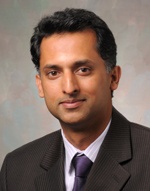

Abraham Joy is an Assistant Professor in the Department of Polymer Science at the University of Akron, USA. Recently we had the opportunity to interview him about his research within biomaterials- and biomedical applications.
Professor Joy has a Ph.D. in Organic Chemistry from Tulane University. He carried out postdoctoral work in the area of bioorganic chemistry at Georgia Tech. Subsequently he did a second postdoc at the New Jersey Center of Biomaterials, and that’s where he started working with polymers and specifically within biomaterials applications which lead him to his position at Akron. Now let’s get to the interview:
“My group works on developing materials for biomedical applications and we utilize skills of organic chemistry and polymer chemistry to address some emerging needs within biomedical applications. A current focus area in the lab is in designing densely functionalized materials. If you think about natural polymers such as proteins, they have a variety of functional groups. As a consequence of their functional groups and their 3D arrangement they have a wide variety of properties and functions. Synthetic materials such as PLGA or PCL are used for their mechanical or physical properties but they don’t have any functionality designed into them.
So we are trying to demonstrate the idea of developing synthetic materials wherein they have the traditional advantages of reproducibility and scale-up, but also the type of functionality seen in peptides. At the end of the day we have materials, or a biomaterial platform, that has all the functional groups that look as if they were peptides but the backbones are either polyesters or polyurethanes. Such densely functionalized polyesters and polyurethanes can potentially be used for several biomedical applications wherein a degradable or a non-degradable platform would be required.”
“So what we hypothesize is that because these peptide-like polyesters have so many types of functionalities we could access several different areas. But as a matter of what we first started with and due to the expertise of our collaborators, we are now working on the following areas: one area is where we are trying to use the functionalities of these polymers to direct stem cell differentiation. […] Another area that we are engaged in is to design functionalized polyesters that mimic bio-glue or bio-adhesives such as those secreted by mussels.
Another application that we are currently exploring is to design synthetic mimics of antimicrobial peptides. These peptides have a large number of cationic residues and a large number of hydrophobic residues. Incorporating cationic lysine or arginine mimics and hydrophobic valine or phenylalanine mimics is something that we can easily engineer into the design of our polyesters or polyurethanes. So we make polymers with varying compositions of a lysine mimic and a valine mimic and examine antimicrobial activity against strains like E-coli or Staphylococcus Aureus and we are seeing promising data to indicate that they do have antimicrobial activity.
The advantage here is that because it is a modular platform, we can make materials water soluble, or hydrophobic; we can make them high molecular weight or low molecular weight. So the design feature allows you to access very different properties. We could make them water soluble where they would function as an injectable therapeutic or as a high molecular weight polymer where you coat it onto an implant to make the implant antimicrobial.”
“Yes it is exactly for those kinds of applications. Now if you talk to medical device companies, they would like to have, let’s say a polyurethane coating that presents some form of antimicrobial activity. And the most common way is to incorporate silver ions into the polymer, but we are trying to make the material itself present antimicrobial properties without having to leach out other agents that are added in there so that we can prevent biofilm formation.
-So shifting gears a little bit more to you personally, what drives you in your research? What motivates you to work in these areas?
“I am a chemist, or an organic chemist, at heart and I think that what is common in a lot of organic chemists is that desire to create new things at the molecular level. And what drives me is the question of whether we can we make synthetic materials that present the functionality and the specificity that is seen in natural proteins and antibodies? Traditional polymers are inert materials that you make a device from, or fabricate something with, or you make a coating of. But I am trying to challenge that a little bit more and say; can we make materials intelligent or with the specificity that they will actually function as therapeutics rather than being just an inert device? It will be a long way till we get there, but academia lets you at least ask those questions and work towards that goal.”
- Where do you think, or hope, this research will be in 5 or 10 years? What are the challenges?
"5 years is a short time but 10-20 years down the line I am pretty confident that if more people are able to see the needs of these materials and take up that challenge, then we would make significant inroads towards these kinds of programmed biomaterials. But I think one of the biggest challenges that I see is in terms of regulation. A common trend in the biomaterials field is to make materials that would be the easiest to get through FDA or European regulatory agencies. That creates the mentality to play it safe and you work on materials that have already gone through these processes. So the incentive to take risks is taken away because when you make a new material for therapeutics it has a very long pathway to market. But because I am fortunate to be in an academic environment I have the luxury of being able to take that risk and unlike companies I don’t have to turn a profit every year. So my challenge, and for people in the field, is to look at things in the long term and push the boundaries of what is known in the field. Out of this long term vision, transformative technologies will emerge."
- Are there any key opinion leaders in biomaterials who have influenced you or your work?
“I tend to look at people who are thinking broadly about things. So I am fascinated by the work of people like Dave Tirrell, Laura Kiessling, Ron Zuckerman, Carolyn Bertozzi, Jeff Hubbell, Bill Murphy, Peter Shultz and others who are working in the exciting interface between materials science and biology.
- Finally, what advice would you have for undergraduate or grad students that are thinking about a similar career path?
"In spite of the current funding climate, I would advise the next generation that this career choice has potential to be very rewarding. I see my career as a privilege and a great responsibility. It provides the rare gift to work on topics you are passionate about and the opportunity to observe and learn something new every day. However this research enterprise is also a great responsibility that is funded mostly by tax payer money. Therefore each of us has to be thoughtful of the long term and short term output of one’s research program and has to provide significant fundamental knowledge or applied technology back to the funders.
My advice to students would be: First they should ask themselves: Is this the career that they want? If so, they should try it – get research experiences while in high school or during their undergrad education before joining a PhD program. Two: I have learnt that it is not enough to do well in your PhD research work. They have to think about what motivates them, and if these research areas will be interesting when they are looking for a job and what they need in terms of developing the skill-set and research experience to get them the job they desire. Then go out there to meetings and conferences and showcase your talents because you need to network with potential employers.”
Professor Joy rounds up the interview by saying: “I am grateful every day for this privilege” and from the enthusiasm he has been showing throughout the interview, you can really tell he is!
Learn about the effect of surface roughness and wettability on biocompatibility of biomaterials and medical devices.
Contact angle measurements help to evaluate the adhesion and performance of biomedical coatings.
Contact angle measurements offer insight into the behavior of a biomedical device in the human body.
Sign upp for the webinar to learn more about how QCM-D is used to study biomaterial-induced activation of the immune system
The concept of wettability, its importance in biomaterials, and how it can be manipulated to improve biocompatibility and overall performance are reviewed.
Read about how QSense QCM-D analysis is used in the quest to tackle inflammation and bacterial infections on implant surfaces.
Learn about the past and future development of biomaterials in regenerative medicine.
Learn about the distinction between the two concepts biomaterials and tissue engineering and how they relate to each other.
Learn more about how biocompatibility is defined and what this property entails
Anna Oom is a former employee at Biolin Scientific where she worked as Project Manager in Marketing and previously as an Application Specialist for QSense. Anna holds a Master’s degree in Chemical Engineering and is fascinated by all the things in everyday life that are rooted in surface science.
